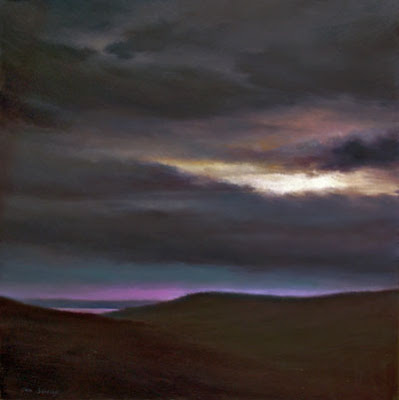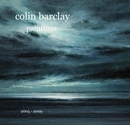
THE CANVAS- June 2010
by Suzette McAvoy
Colin Barclay, Sean Beavers and Lisa Creed
“He drew forth a phrase from his treasure and spoke it softly to himself: A day of dappled seaborne clouds.” -James Joyce, A Portrait of the Artist as a Young Man
Colin Barclay, Storm on the Barrens, 2007, oil on paper laid to panel, 24” x 24”
Nature’s Emotive Power
Contemporary landscape painter Colin Barclay’s Storm on the Barrens brings to mind a line from the English romantic poet Percy Shelley: “Far clouds of feathery gold, shaded with deepest purple, gleam like islands on a dark blue sea.” Simply composed, yet richly layered with scumbled opaque colors and thin veils of sheer tint, Barclay’s radiant landscapes seem to channel the emotive power of nature.
A native of New York’s Hudson River Valley, Barclay has a deep appreciation for the natural beauty of the region, which in the opening decades of the nineteenth century gave rise to America’s first recognized school of landscape painting. Like his artistic forbears, Barclay seeks to acknowledge the awe-inspiring beauty of a world undisturbed by man. Now a resident of Maine, he travels frequently throughout the northeast and as far north as the Bay of Fundy in search of inspiration for his meditative images.
While decidedly modern in his aesthetic approach, Barclay freely acknowledges the historical origins of his art. In particular, he appreciates the work of the late-nineteenth-century artist George Inness, whom he quotes as saying, “the aim of a work of art is not to instruct, not to edify, but to awaken an emotion.” Not surprisingly Barclay also admires the Luminists—Fitz Henry Lane, William Trost Richards, Martin Johnson Heade, Sanford Gifford, and others—whose spare, refined compositions and poetic use of light communicate “deep emotional and spiritual content.”
Barclay’s artistry is revealed in the visual emphasis he places on the abstract elements of a scene. He consciously simplifies forms, clarifies shapes, and modulates color and light until “a kind of kinetic balance” is reached. “I never want to paint a static landscape where everything seems at rest,” he says, “I always push for the work to feel as if it’s suspended or tensed against itself—just caught in the midst of movement.”

Temporal Moments
Artist Sean Beavers paints a variety of themes—still lifes, landscapes, and figurative works. Yet no matter the subject, all of his exquisitely rendered images address the tension between beauty and despair. For him, painting provides the opportunity to address the temporality of life by capturing nature’s fleeting moments. “All life is temporary,” he says, “I think that’s part of the reason that I paint; to somehow delay that process, to hold on a little bit longer to a moment or thing that will never exist again.”
In Distant Hiding Place, Beavers shares with the viewer one of nature’s uniquely beautiful moments. A cloud hovers over a tidal outlet in the sand; the two forms echoing one another and conveying a sense of spiritual transcendence. The painting is part of an ongoing series called Whispers from the Voice of the Sky, and was created from a plein-air study produced on the beach in York. “When I study something in nature,” the artist says, “there is a connection or understanding that I can’t describe—the beauty just moves me. When I say beauty I don’t mean sweet or sentimental. Nature can be quite harsh at times, but there is always balance in it, something melodic to offset the dissonance.”
Beavers’s meticulous painting style reveals a strong expertise in drawing from life, a practice that he has pursued from childhood and from which he still derives “immeasurable inspiration.” He considers his work to be “symbolist,” and his hauntingly beautiful images move beyond representation into the manifold evocations of metaphor. “The subjects of my paintings usually represent something other than the objects themselves,” he says, “like dreams, desires, frustrations, spirit—whatever it is I’m thinking about at the time.” While his art is inspired by deeply personal intentions, it speaks to the universal quest for truth and beauty.
Sean Beavers, Distant Hiding Place, oil on canvas on panel, 30” x 30” Private collection

Infinite Seas and Endless Skies
In her paintings of the sea and sky, artist Lisa Creed seeks “to honor the numinous that surrounds us.” Although she now resides in North Carolina, Creed grew up spending summers on the coast of Maine and she returns each year to spend time at her family’s property in Surry. “I feel like I have absorbed the very coast that I grew up on into my bones,” she says.
It is from this deeply rooted sense of place that she draws inspiration for her lyrical, atmospheric images. Serving as visual testaments of her devotion to nature’s spiritualism, Creed’s semi-abstract paintings of the Maine shore convey her appreciation for the elemental and the infinite. “I may paint in the front field or in my studio,” she says, “but it is my memory that pours out onto the surface. It is that sense of wonder that I had as a kid and still have today. It is the power of the sky, sea, and land, and the shifting weather that intrigues me.” In painting after painting, Creed expresses her appreciation for the inimitable light and air of the Maine coast. It is her only landscape subject—she also paints abstractions—and her passionate dedication to the theme is revealed in the remarkable range she derives from the subject. The vast skies and endless seas are as seemingly various as nature’s own creations. Devoid of human presence or man-made structures, her coastal paintings celebrate the transitory, ever-shifting nature of weather, atmosphere, and light. In works such as On the Wing, sweeping veils of shimmering color define the surface of the water and give form to the cloud-filled sky. “It is without fail that various people will comment that my work has northern light in it,” says Creed. “They recognize that it is New England light, Maine light. It is impossible for me to not have that light I love in my work.”
Lisa Creed, On the Wing, 2006, acrylic on canvas, 42” x 42”




